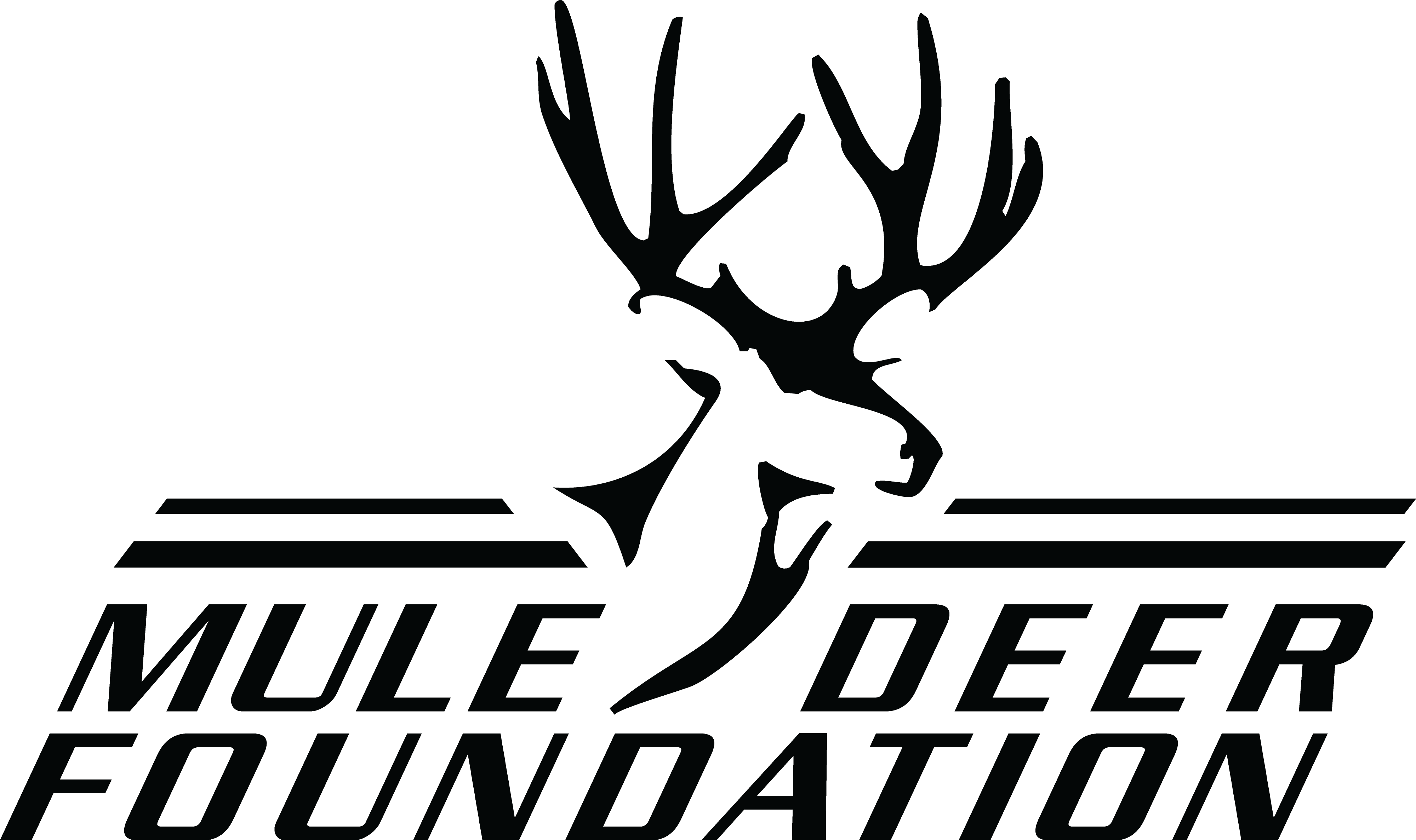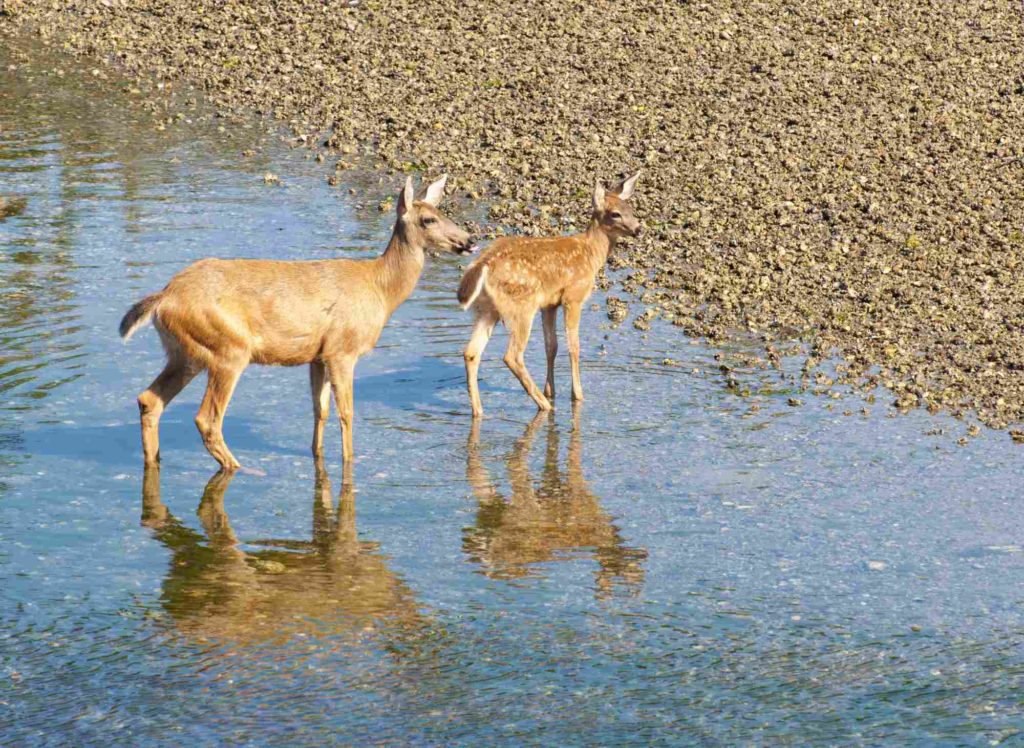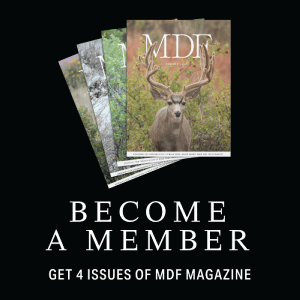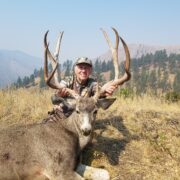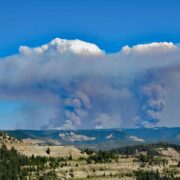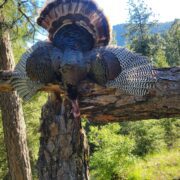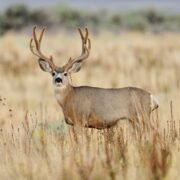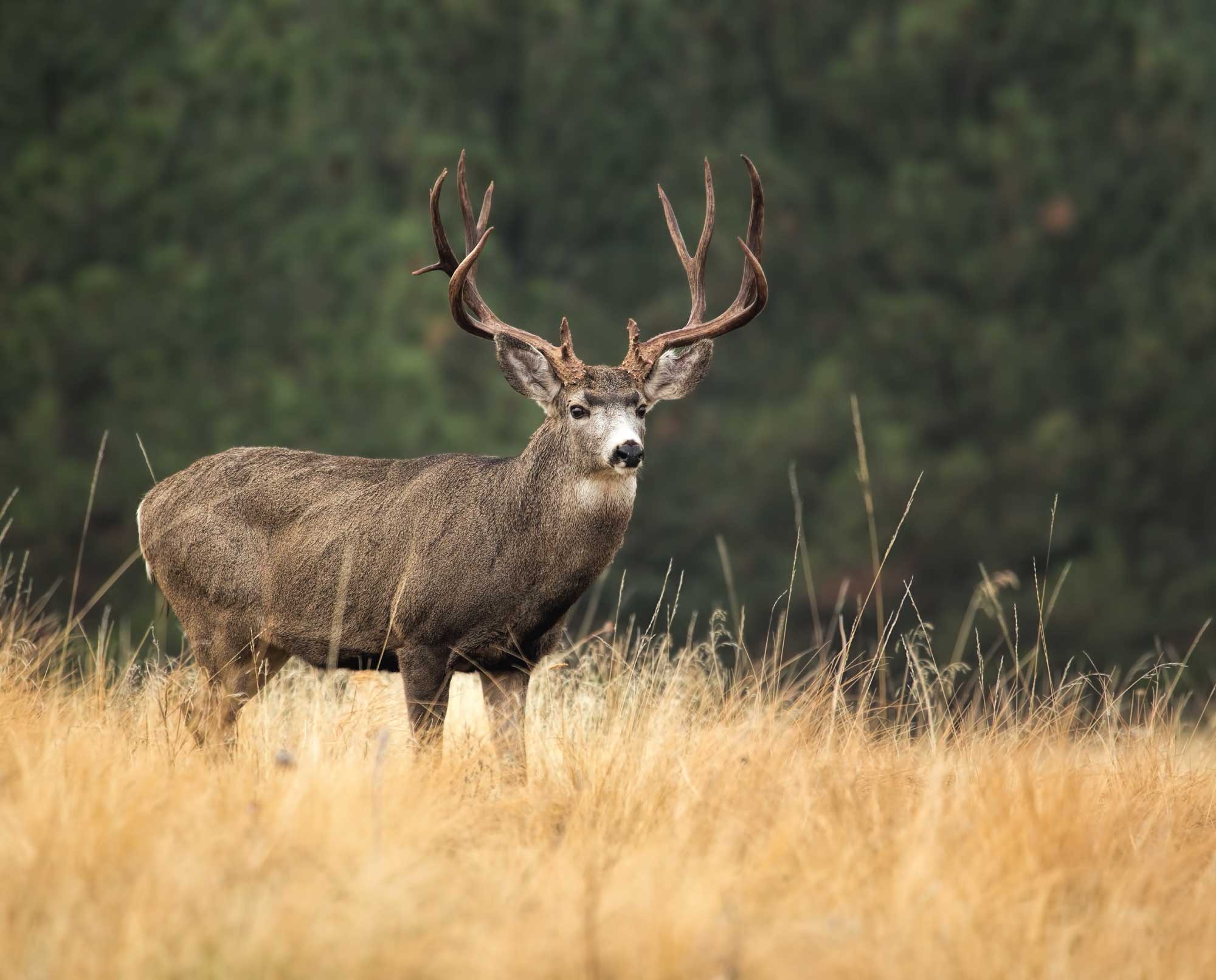
Mule deer (Odocoileus hemionus) are often regarded as ‘The Deer of the West’ and are one of the most iconic animals in western North America.
Description:
Mule deer and black-tailed deer (collectively known as ‘mule deer’) are known for their uniquely large ears resembling those of a mule, earning them the species name hemionus meaning ‘half-mule’. They have mostly brown-gray coats with visible cream or white colored rumps. Adult mule deer typically range in weight from 125-300lbs, standing around 3.3 feet tall at the shoulder 1. Mule deer are distributed throughout western North America from the coastal islands of Alaska, down the Pacific Coast of California to southern Baja Mexico and from the extreme northern portion of the Mexican state of Zacatecas, northward through the western Great Plains to the Canadian provinces of Saskatchewan, Alberta, British Columbia and the southern Yukon Territory 2. Subtle differences in mule deer occur depending on where they live. There have been as many as 11 subspecies of mule deer described 1.
Black-tailed deer are a subspecies of mule deer found in the coastal regions of northwestern North America from California to Alaska. Black-tailed deer are categorized by two common mule deer subspecies: Columbian black-tailed deer (Odocoileus hemionus columbianus) and Sitka black-tailed deer (Odocoileus hemionus sitkensis) 3. Columbian blacktails can be found in the coastal areas of northern California, Oregon, Washington, and southern British Columbia, whereas the Sitka subspecies are found on coastal areas of northern British Columbia and southeastern Alaska. Black-tailed deer are differentiated by their body and antler size, color, geographical distribution, habitat preference, and even their DNA. Aptly named, the tail of black-tailed deer is black from tip to rump.
Differences between Mule Deer and White-tailed Deer:
In many parts of their distribution, mule deer overlap with a closely related species, the white-tailed deer (Odocoileus virginianus). Sometimes mule deer and white-tailed deer will hybridize, but this is a rare phenomenon. Understanding their differences is important for proper identification. Although similar in many respects, mule deer and white-tailed deer are distinguishable in their behavior, biology, and appearance. For example, the most commonly noted difference between the two species is their antler configuration 1. Mule deer usually have small or missing brow tines with bifurcated antler branching, which means tines that split once off of a main beam, and then again toward the tips. White-tailed deer antlers usually have prominent brow tines, and tines that split once directly off the main beam. Another distinguishable characteristic between mule deer and whitetails is the appearance and color of their rump. Mule deer have a rope-like tail with a distinctive black tip, while whitetails have a more flat, triangular-shaped tail that is brown on the back surface, and a pure white bottom.
Reproduction:
The breeding season (rut) generally occurs in November or December, but can vary based on location. For example in the Southwest Desert, the rut may occur as late as January-February. The rut is synchronized with the doe’s annual estrous cycle, meaning the period of time when she can become pregnant. Bucks spar during the rut, competing for receptive does. Older bucks with large antlers usually outcompete younger bucks with smaller antlers for mates, but that is not always the case 4. After being bred, does begin a 7 month gestation period and fawns are dropped in late spring and summer: coinciding with an abundance of nutritious food for lactation 1. Females give birth to usually one or two fawns, with twins being more common among does in prime breeding age whose nutritional needs are met. Fawn to doe ratios are often used by wildlife managers as an important marker for mule deer population health. Fawns may weigh between 5-6 pounds, and heavier fawn weights are usually indicative of good maternal nutritional status and a higher probability of fawn survival 5.
Diet, Nutrition, and Habitat:
Mule deer are herbivores with a four chambered stomach similar to cattle, elk, and other ruminants. They digest food by regurgitating partially digested plants, re-chewing, and resting to allow for bacterial breakdown of plant material 1. Mule deer are not as efficient at digesting fibrous material as cattle and elk, so they feed on plants that provide concentrated and highly digestible nutrients. In order to take advantage of the most nutritious plants throughout the year, mule deer may change their diets seasonally. For example, during the spring and summer, mule deer select food items available during ‘green up’ such as herbaceous flowering plants and grasses 6. During the winter when herbaceous plants die off, mule deer switch to the nutritious buds and leaves of woody vegetation (browse) such as sagebrush, bitterbrush, mountain mahogany, and cliffrose. In the winter when food resources become scarce, mule deer may burn more calories in a day than what they can consume. During this period, loss of body mass can be substantial 5.
Across their distribution, mule deer habitat is broadly categorized in seven ecoregions where mule deer populations share similarities in their ecological associations 1, those ecoregions are: Intermountain West, Great Plains, Northern Forest, Colorado Plateau Shrubland and Forest, Coastal Rainforest, California Woodland Chaparral, and Southwest Desert. Within each ecoregion, there are a wide variety of habitat types mule deer associate to. For example, mule deer of the western Great Plains region have a greater component of open grassland habitat than black-tailed deer in the Coastal Rainforest region. In general, areas with occasional disturbance and edge stimulates growth of grasses, forbs, and shrubs that are within reach of the deer. Consequently, wildfire, grazing, and forest management practices can have an enormous impact on habitat quality.
Migration:
Migration is the seasonal movement between habitats. For mule deer this is typically the biannual movements between high elevation summer range and lower elevation winter range. Not every mule deer is migratory, as some remain on their range year-round 7. Migration is typically prompted by changes in food availability and weather 8. Migration routes can be well over 100 miles in length, and function not only as travel corridors, but also as important foraging habitats 9. The longest documented mule deer migration is over 240 miles from winter range in the Red Desert of Wyoming to summer range near Island Park, Idaho. During migration, mule deer use a series of ‘stopovers,’ which allows them to maximize energy intake along their migration route 10. It is believed that mule deer learn migration routes from their mothers, and typically follow that same route for the rest of their lives 11.
Populations:
Mule deer populations have a history of fluctuating through time 1. Before the West was settled by early pioneers, little is known about mule deer abundance but it is generally accepted that during the 1800’s mule deer numbers were at or below recent numbers 1. The factors adversely affecting mule deer populations today include habitat loss and fragmentation, poor forage quality, drought, severe weather, competition with other ungulates, predation, disease, and poaching 2. Among ecoregions there are diverse environmental and climatic conditions, therefore each ecoregion presents different challenges to mule deer populations 1. For example, in the Southwest Desert ecoregion, drought is a serious concern and water availability is a key factor affecting mule deer populations. However, in the Northern Forest ecoregion, severe winters causing winterkill is often the most important factor impacting mule deer populations. A common thread among all ecoregions is habitat loss and fragmentation, which is commonly cited as the single greatest cause for declines in mule deer populations 12. To find current information on how mule deer populations are doing in your state, see the most recent rangewide status report published by the Mule Deer Working Group13.
Conservation:
Mule deer are one of the most economically and socially important animals in western North America, enjoyed by millions of hunters and wildlife viewers annually1. The challenges facing mule deer now and into the future are many. Effective mule deer conservation begins by becoming familiar with the specific challenges and opportunities facing individual populations. Solutions to these challenges include habitat restoration, invasive species management, and wildlife-friendly fencing—solutions that make a real difference for mule deer. Groups like MDF are committed to sustaining our western deer populations by ensuring quality habitat in the areas deer need on a daily, seasonal, and yearly basis. MDF also encourages and supports responsible, science-based wildlife management with government agencies, private organizations, and landowners. MDF has long been a supporter of the WAFWA Mule Deer Working Group, which is established to find solutions to common mule deer management problems and to optimize research and management in the western states and provinces. Working together to tackle these large conservation issues, the future for mule deer is bright.
Sources:
1 deVos, J. C., Conover, M. R. & Headrick, N. E. Mule Deer Conservation: Issues and Management Strategies. (Berryman Institute Press, 2003).
2 Mule Deer Working Group. North American Mule Deer Conservation Plan. (Western Association of Fish and Wildlife Agencies, 2004).
3 Nelson, J. et al. Habitat Guidelines for Black-tailed Deer: Coastal Rainforest Ecoregion. (Mule Deer Working Group, Western Association of Fish and Wildlife Agencies, 2008).
4 Heffelfinger, J. Deer of the Southwest. (Texas A&M University Press, 2006).
5 Monteith, K. L. et al. Life-history characteristics of mule deer: Effects of nutrition in a variable environment. Wildlife Monographs 186, 1-62, doi:https://doi.org/10.1002/wmon.1011 (2014).
6 Aikens, E. O. et al. Wave-like Patterns of Plant Phenology Determine Ungulate Movement Tactics. Current Biology 30, 3444-3449.e3444, doi:https://doi.org/10.1016/j.cub.2020.06.032 (2020).
7 Berg, J. E., Hebblewhite, M., St. Clair, C. C. & Merrill, E. H. Prevalence and Mechanisms of Partial Migration in Ungulates. Frontiers in Ecology and Evolution 7, doi:10.3389/fevo.2019.00325 (2019).
8 Monteith, K. L. et al. Timing of seasonal migration in mule deer: effects of climate, plant phenology, and life-history characteristics. Ecosphere 2, art47, doi:https://doi.org/10.1890/ES10-00096.1 (2011).
9 Sawyer, H., Middleton, A. D., Hayes, M. M., Kauffman, M. J. & Monteith, K. L. The extra mile: Ungulate migration distance alters the use of seasonal range and exposure to anthropogenic risk. Ecosphere 7, 1-11, doi:10.1002/ecs2.1534 (2016).
10 Sawyer, H. & Kauffman, M. J. Stopover ecology of a migratory ungulate. Journal of Animal Ecology 80, 1078-1087, doi:10.1111/j.1365-2656.2011.01845.x (2011).
11 Jesmer, B. R. et al. Is ungulate migration culturally transmitted? Evidence of social learning from translocated animals. Science 361, 1023, doi:10.1126/science.aat0985 (2018).
12 Mule Deer Working Group. Mule Deer: Changing Landscapes, Changing Perspectives. (Western Association of Fish and Wildlife Agencies, 2002).
13 Mule Deer Working Group. Range-Wide Status of Black-Tailed and Mule Deer. 46 (Western Association of Fish and Wildlife Agencies, 2021).


